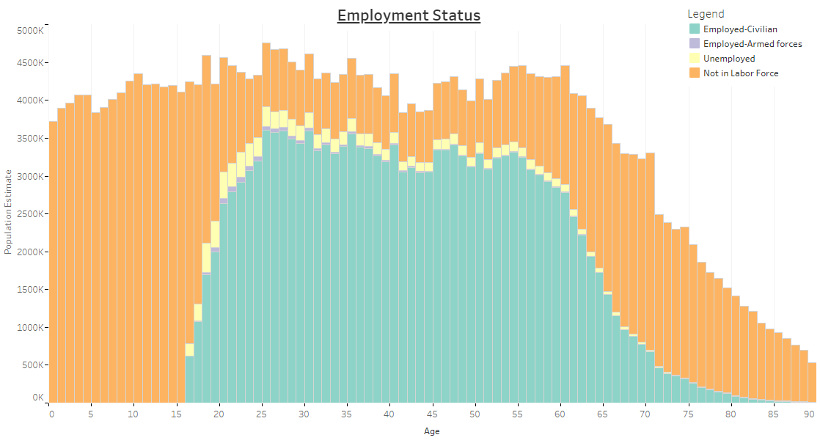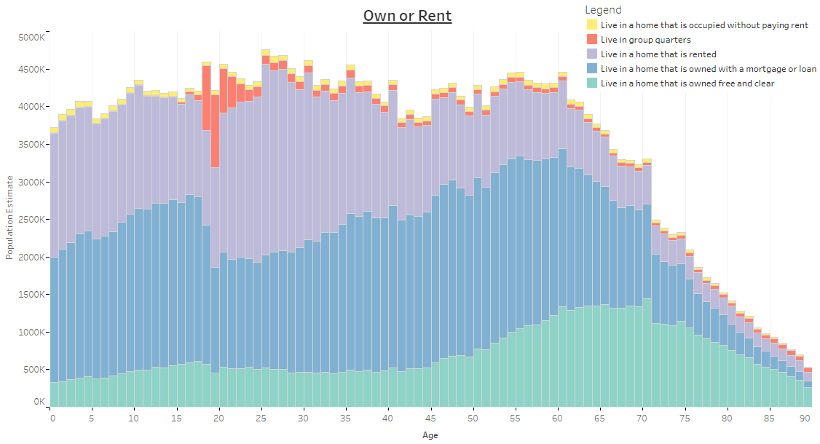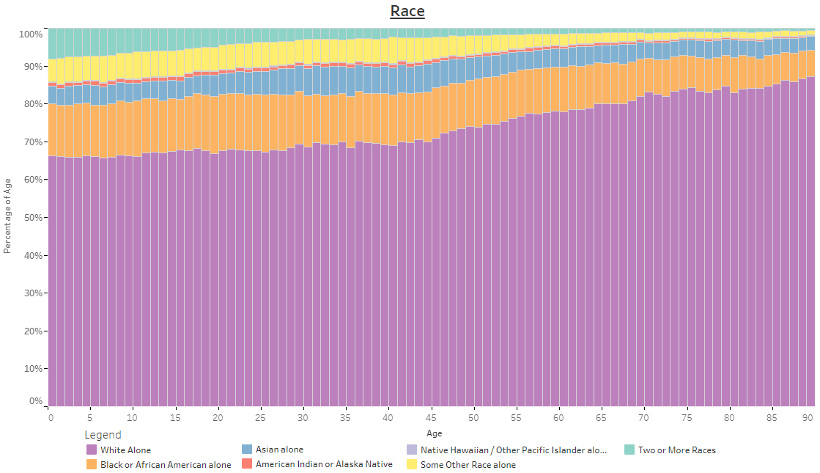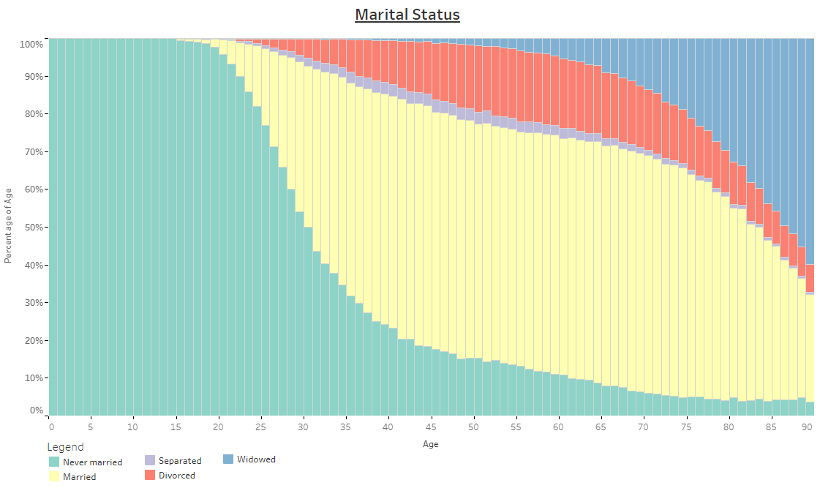While we each intrinsically know that our days as teenagers will be vastly different from those as senior citizens, it is interesting to see how this looks from a 10,000-foot perspective. Using demographic data on the American populace, we can spot key differences between age groups, including some aspects that make each generation of Americans unique.
The U.S. Population, by Age
Today’s interactive data visualization comes to us from Overflow Data, and it charts out the entire U.S. population by age group. The graphic allows you to sort demographics based on data pertaining to specific topics—such as whether people own or rent their house—to see how age affects answers to these different questions. The interactive visualization also allows you to filter results by geographic region, sex, marital status, or employment status. Data here comes from the 2017 Public Use Microdata Sample (PUMS) via the American Community Survey, which is published by the U.S. Census Bureau.
Gauging Differences
Let’s dive into how American differ by age, by looking at some specific charts: Employment Status, by Age This is a simple one to start with, but it makes it easy to see how the data works. In the below chart, it’s evident that most younger and older Americans are not in the labor force, while the majority of working age Americans are employed or seeking work (unemployed).
Own or Rent, by Age How about looking at whether Americans own or rent, or even if they live in a group quarters?
Race, by Age The below chart is sorted by percentile, and it shows the percentage of individuals by race according to their age group. As the population skews younger, so does its racial diversity.
Marital Status, by Age The below chart is sorted by percentile, and it shows the marital status (married, divorced, etc.) of different age groups.
The Generational Effect
For more on how Americans differ by age, learn about how different generations approach the workplace, as well as how they think about investing. on Even while political regimes across these countries have changed over time, they’ve largely followed a few different types of governance. Today, every country can ultimately be classified into just nine broad forms of government systems. This map by Truman Du uses information from Wikipedia to map the government systems that rule the world today.
Countries By Type of Government
It’s important to note that this map charts government systems according to each country’s legal framework. Many countries have constitutions stating their de jure or legally recognized system of government, but their de facto or realized form of governance may be quite different. Here is a list of the stated government system of UN member states and observers as of January 2023: Let’s take a closer look at some of these systems.
Monarchies
Brought back into the spotlight after the death of Queen Elizabeth II of England in September 2022, this form of government has a single ruler. They carry titles from king and queen to sultan or emperor, and their government systems can be further divided into three modern types: constitutional, semi-constitutional, and absolute. A constitutional monarchy sees the monarch act as head of state within the parameters of a constitution, giving them little to no real power. For example, King Charles III is the head of 15 Commonwealth nations including Canada and Australia. However, each has their own head of government. On the other hand, a semi-constitutional monarchy lets the monarch or ruling royal family retain substantial political powers, as is the case in Jordan and Morocco. However, their monarchs still rule the country according to a democratic constitution and in concert with other institutions. Finally, an absolute monarchy is most like the monarchies of old, where the ruler has full power over governance, with modern examples including Saudi Arabia and Vatican City.
Republics
Unlike monarchies, the people hold the power in a republic government system, directly electing representatives to form government. Again, there are multiple types of modern republic governments: presidential, semi-presidential, and parliamentary. The presidential republic could be considered a direct progression from monarchies. This system has a strong and independent chief executive with extensive powers when it comes to domestic affairs and foreign policy. An example of this is the United States, where the President is both the head of state and the head of government. In a semi-presidential republic, the president is the head of state and has some executive powers that are independent of the legislature. However, the prime minister (or chancellor or equivalent title) is the head of government, responsible to the legislature along with the cabinet. Russia is a classic example of this type of government. The last type of republic system is parliamentary. In this system, the president is a figurehead, while the head of government holds real power and is validated by and accountable to the parliament. This type of system can be seen in Germany, Italy, and India and is akin to constitutional monarchies. It’s also important to point out that some parliamentary republic systems operate slightly differently. For example in South Africa, the president is both the head of state and government, but is elected directly by the legislature. This leaves them (and their ministries) potentially subject to parliamentary confidence.
One-Party State
Many of the systems above involve multiple political parties vying to rule and govern their respective countries. In a one-party state, also called a single-party state or single-party system, only one political party has the right to form government. All other political parties are either outlawed or only allowed limited participation in elections. In this system, a country’s head of state and head of government can be executive or ceremonial but political power is constitutionally linked to a single political movement. China is the most well-known example of this government system, with the General Secretary of the Communist Party of China ruling as the de facto leader since 1989.
Provisional
The final form of government is a provisional government formed as an interim or transitional government. In this system, an emergency governmental body is created to manage political transitions after the collapse of a government, or when a new state is formed. Often these evolve into fully constitutionalized systems, but sometimes they hold power for longer than expected. Some examples of countries that are considered provisional include Libya, Burkina Faso, and Chad.

















